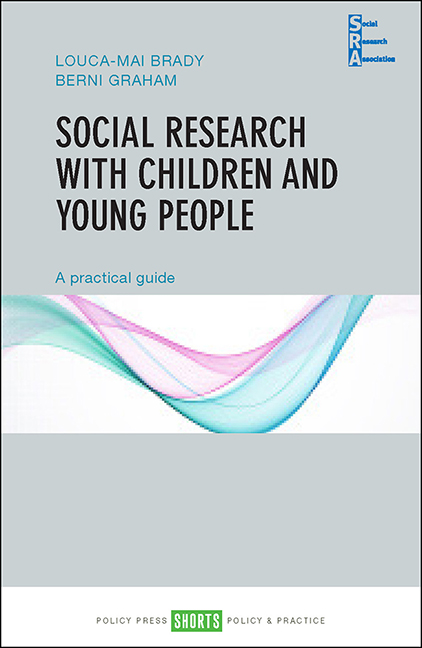Book contents
- Frontmatter
- Contents
- List of illustrations
- Notes on authors
- 1 Introduction
- 2 The context for social research with children and young people
- 3 Involving children and young people in research
- 4 Ethical considerations
- 5 Designing appropriate methods for children and young people
- 6 Conclusions
- Bibliography
- Index
- Social Research Association Shorts
5 - Designing appropriate methods for children and young people
Published online by Cambridge University Press: 13 April 2022
- Frontmatter
- Contents
- List of illustrations
- Notes on authors
- 1 Introduction
- 2 The context for social research with children and young people
- 3 Involving children and young people in research
- 4 Ethical considerations
- 5 Designing appropriate methods for children and young people
- 6 Conclusions
- Bibliography
- Index
- Social Research Association Shorts
Summary
Introduction
This chapter provides an overview of key issues and considerations in designing robust methodologies, methods, indicators and tools for children and young people. Poorly considered methods and questions, which includes those which do not match diverse circumstances and needs, can result in low response rates, biased answers and poor data. Methods, tools and questions which work well with adults need careful reconsideration and adaptation to suit children and young people.
It is not possible to cover every research permutation, but the principles suggested should help build a framework applicable to most studies. This chapter focuses on common primary qualitative and quantitative methodologies. Literature reviews and the secondary use of administrative, social media or other big data are not discussed as there does not seem to be a particular children's or young people's angle to the methods per se.
The chapter aims to address issues and practical solutions which most generalist publications omit. Do not be daunted: to be comprehensive it needs to cover a range of research circumstances, but not all apply in each research study. Moreover, the chapter provides plenty of suggestions, along with examples, drawn from the authors’ extensive experience. A key bedrock is inclusivity and careful planning. After looking overarching at design principles, including diversity, accessibility, sensitive topics and practical factors, this chapter looks at the specific considerations in adapting common quantitative and qualitative approaches and developing creative methods. Rather than attempting to provide an exhaustive set of instructions, or examples for every potential permutation (which is probably impossible), the emphasis here is on providing general parameters to ensure methods are appropriate and accessible.
Planning methods and questions to match the diversity of children and young people
As discussed in previous chapters, although ‘children and young people’ is a widely used term, they are a far from homogeneous group. Researchers need to consider all children and young people, and/or the particularities of a precise target group when determining the best methodology. Taking an inclusive approach involves looking beyond collecting data from the easiest to reach, including the voices of those less frequently heard and avoiding over-researching some sub-groups. From the outset, it is best to presume that you will be working with numerous, if overlapping groups, who share some commonalities (typically age).
- Type
- Chapter
- Information
- Social Research with Children and Young PeopleA Practical Guide, pp. 101 - 136Publisher: Bristol University PressPrint publication year: 2018



